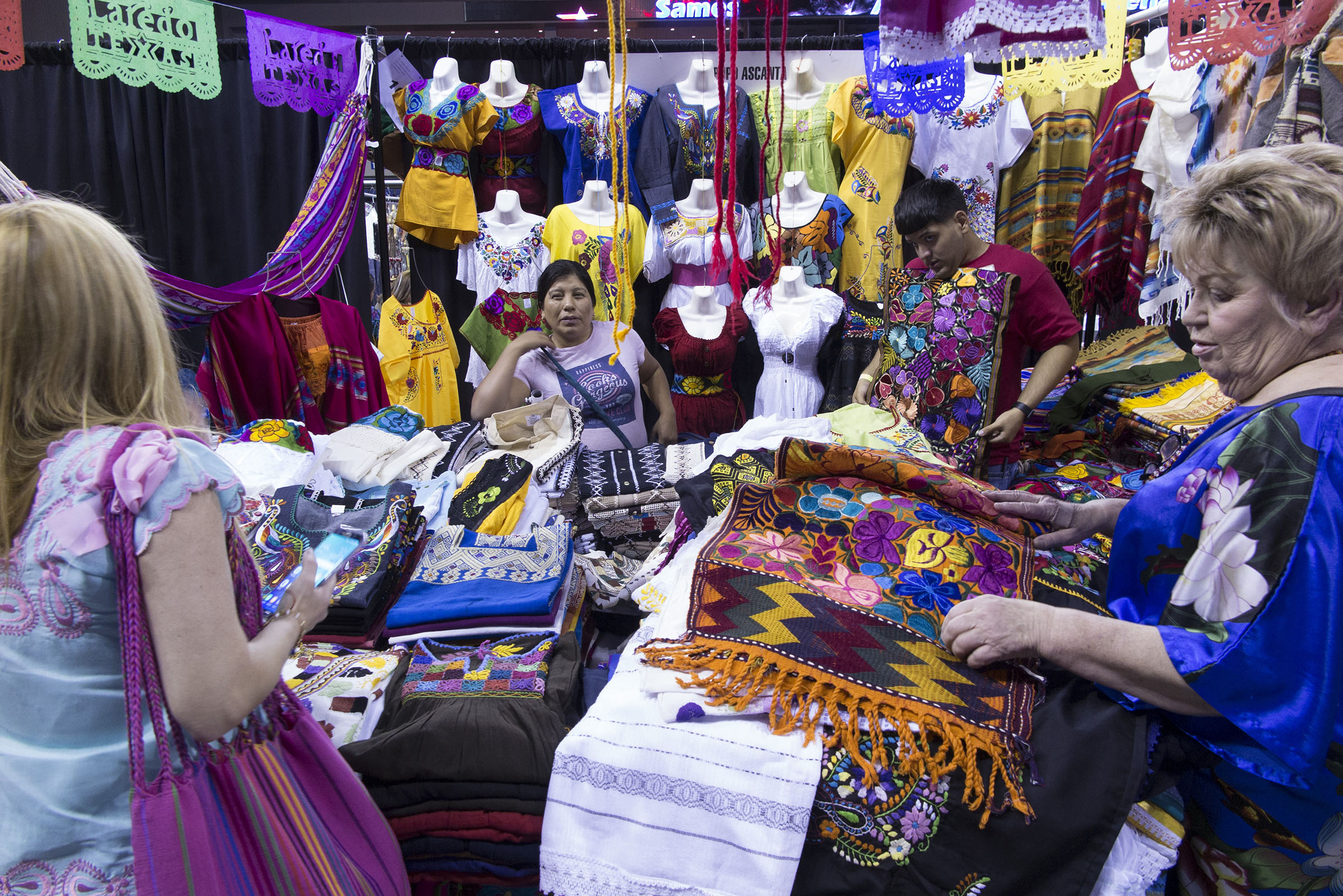
Merchandise at the International Sisters City Festival runs the gamut, from handmade rugs to carved furniture to candies. Photo by Kevin B. Stillman
Laredo, the bustling border city in South Texas (and my hometown) has for decades had a strong sister cities culture. When I was in high school in the mid-aughts, I traveled deep into Mexico with the Laredo Sister Cities Youth Group. We visited some of our numerous sister cities like Queretaro and San Miguel de Allende. We delivered donations to schools, met city officials, and had the opportunity to meet young people just like us, coming of age and learning how we were more alike than different. Later that same year, we welcomed those young people, and a couple thousand other visitors, to Laredo for the International Sister Cities Festival.
While city officials shook hands and planned business opportunities, I remember perusing the aisles of artisanal crafts for sale, sitting in awe of traditional folklórico dancers and mariachis, and, most importantly, practicing my horrid Spanish, trying to get to know the young visitors better.
Established in 2002 through a partnership with the city of Laredo and the husband-and-wife team of Cheli and Javier Amieva, Mexican newspaper owners who had strong relationships with small businesses and city governments in Mexico, the International Sister Cities Festival has humble beginnings. “I remember the very first event,” Javier says. “There were something like 20 vendors at the old Laredo Civic Center that doesn’t even exist anymore.”
“At the start,” Cheli adds, “we had more city officials there than visitors.”
Twenty-one years later, with the festival now in its 19th edition and taking place at the Sames Auto Arena, the couple, along with partner Estella Naranjo, are still the heartbeat of the operation. They scour Mexico and Latin America for new vendors and help them with the logistics of coming to the United States to sell their goods and grow their business.
From the start, the mission of the festival has been three-pronged: the market, the municipal, and the cultural.
The largest, of course, is the market, where artisans and small businesses from Laredo’s sister cities and beyond showcase and sell their wares. Some vendors from the farthest sister cities like San Luis Potosi travel over 500 miles to get to Laredo. Other vendors, who are invited by the Ameivas and Naranjo, travel over 3,000 miles from the deep interior of Mexico, Latin America, and even Ecuador and Peru. They bring handmade rugs, silk rebozos, one-of-a-kind wood carved furniture, pottery, jewelry, candies, toys, and so much more.
“The entire floor is filled with booths of everything you can ever imagine,” says Erica Contreras, who used to volunteer at the festival as a college student. “The colors are amazing. It’s our culture, and it just makes you proud that people are out here buying these beautiful items.” Contreras is now the director of marketing at the Outlet Shoppes at Laredo, an official partner with the festival.
Outside the market floor, a food court with Mexican food vendors keeps guests fueled up for the shopping spree. “Oh my God, you can taste all of Mexico in one place,” says Raymond Camina, owner of Basket and Pottery Alley, one of the few local stores to sell at the festival.
If you arrive early on Friday, you’ll catch a glimpse of the diplomatic aspect of the festival, where representatives from attending cities meet, talk shop, and strengthen relationships for various economic opportunities at the official ribbon cutting.
Cultural sharing is also paramount to the festival. In addition to the folk dancers and musicians who perform throughout the weekend, the Amievas and Naranjo say the relationship-building between the vendors, crew, visitors, and volunteers is one of the highlights of the event, with volunteers asking for the same vendors year after year, learning their histories, and becoming lifelong friends. “We have many, many histories,” Naranjo says, “and we are very proud.”
From 20 vendors in 2002 to more than 200 today, the festival has become so popular there’s now a waiting list for new vendors, says Aileen Ramos, the director of the Laredo Convention and Visitors Bureau. “It’s as many as we can fit in the arena,” she says. According to its website, the Sames Auto Arena, where the festival moved in 2010, boasts 32,000 square feet of continuous open floor space, which makes it the largest indoor convention space in South Texas. Ramos says attendance for the three-day festival peaked in 2019 with 25,000 visitors and isn’t far off after a two-year absence thanks to the pandemic.
If you don’t know Laredo or only think you do, Ramos says, the festival is a great excuse to finally pay a visit. “It’s the perfect opportunity for people to see that there are things that are valuable from every type of place. It’s the perfect opportunity for people to get to know us.”
The Laredo Sister Cities International Festival will be held July 14-16 at Sames Auto Arena in Laredo. Parking and entrance to the festival is free. Though some vendors take credit cards, not all do, and cash is preferred. ATMs are available on site. Please review the Sames Auto Arena bag policy here.








